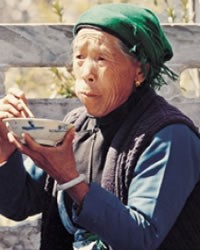Nanjingren in China

Photo Source:
Copyrighted © 2026
Operation China, Asia Harvest All rights reserved. Used with permission |
Send Joshua Project a map of this people group.
|
| People Name: | Nanjingren |
| Country: | China |
| 10/40 Window: | Yes |
| Population: | 162,000 |
| World Population: | 162,000 |
| Primary Language: | Chinese, Mandarin |
| Primary Religion: | Ethnic Religions |
| Christian Adherents: | 7.50 % |
| Evangelicals: | 6.80 % |
| Scripture: | Complete Bible |
| Ministry Resources: | Yes |
| Jesus Film: | Yes |
| Audio Recordings: | Yes |
| People Cluster: | Tibeto-Burman, other |
| Affinity Bloc: | Tibetan-Himalayan Peoples |
| Progress Level: |
|
Introduction / History
The official classification of the Nanjingren by the Chinese authorities has been extremely problematic. In the 1982 census they were placed in a list of Undetermined Minorities. In 1987 the authorities decided that most Nanjingren were assimilated, and that the remaining 2,000 people who retain their ethnicity had become members of the Longjia minority group. The Longjia themselves, however, were not granted status as a minority group. In the late 1980s they were "discovered" to be a branch of the Bai nationality, the majority of whom live around Dali in western Yunnan Province. To complicate an already confused situation, the Nanjingren were told they could choose which nationality they wanted to be under. As a result, today there are Nanjingren who are classified as Gelao, Yi, or Han Chinese. In Qianxi County the Nanjingren call themselves Xienan, and in Dafang they use the name Xiejing. The Yi call them Awutu; the Miao know them as Shiye; and the Han call them Gejiaoren.
The Nanjingren in Guizhou are historically like the Chuanqing and Chuanlan groups. Nanjing is the large, former capital city of China located on the east coast. The Nanjingren claim their ancestors were soldiers sent from Nanjing during the eighth and ninth centuries to fight against Miao insurgents in the mountains.
What Are Their Lives Like?
When several generations had passed after their arrival in the area, the Nanjingren adopted many minority customs, especially from the Miao, and no longer viewed themselves as Han Chinese. Later, Han settlers entered the region in the fourteenth century. Not only did they not consider the Nanjingren as Han people, but in many instances, they persecuted and despised them. When the Nanjingren marry, the bride-price is customarily paid with cows. The traditional dress of the Nanjingren women consists of short-sleeved shirts, long skirts, and a headdress.
What Are Their Beliefs?
Most Nanjingren worship their ancestors. Each home has an ancestral altar on the wall of the main room. Offerings of incense and food are regularly made to the dead, in the belief that it will procure their souls a better existence in the afterlife. When a Nanjingren dies, Daoist priests are called in to conduct the funeral according to Daoist rites.
What Are Their Needs?
Although most Nanjingren have never heard the gospel in such a manner as to intelligently accept or reject Christ, there are about 1,000 Catholic Christians and a few Protestants among them. These believers are the fruit of pre-1949 mission work in the region.
Prayer Points
Pray for a Holy Spirit-sent revival among the Nanjingren people, leading them to holiness and eternal blessings.
Pray for the Lord to thrust out workers to finish the work among the Nanjingren people.
Pray for Nanjingren people to seek and find the savior no matter how difficult community pressure may be.